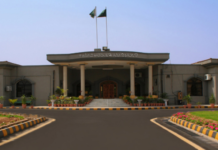Gilgit Baltistan Chief Secretary Abrar Ahmed Mirza said the region has been severely affected by a series of climate-driven disasters over the past two weeks, with at least nine people confirmed dead, more than 200 homes damaged, and major infrastructure left in ruins.
The region, nestled in the north of Pakistan, has seen extreme weather conditions, with glacial melts, heatwaves, and heavy rainfall triggering flash floods and landslides.
Addressing a press briefing on Thursday, the top official said the region initially faced glacial melt and heatwaves, followed by a new spell of heavy rains that triggered flash floods and landslides, particularly in Diamer and Astore districts.
“From June 10 till now, we have confirmed nine fatalities, eight of which occurred in the valleys of Thak and Thor in Diamer, while one death was reported from Astore valley,” he said.
The chief secretary noted that most incidents were caused by glacial lake outburst floods (GLOFs), a phenomenon increasingly common due to rising temperatures and climate change. “We are witnessing the compounded impact of extreme heat and erratic rainfall,” he added.
He said the floods had damaged around 200 homes, disrupted roads and water channels, and cut off several villages in Kharmang district, where bridges collapsed. “All 10 districts of Gilgit Baltistan have been affected to varying degrees, but Diamer remains the hardest hit,” he stated.
According to Mirza, the government launched immediate rescue operations in collaboration with the Pakistan Army, GB Scouts, district administration, and Rescue 1122, with the help of local volunteers. Stranded tourists were also airlifted through army helicopter sorties in inaccessible areas. He acknowledged that travel advisories are regularly issued for high-risk areas, but said that public response remains inadequate. “People tend not to alter their travel plans until the threat becomes imminent,” he observed. -Agencies


